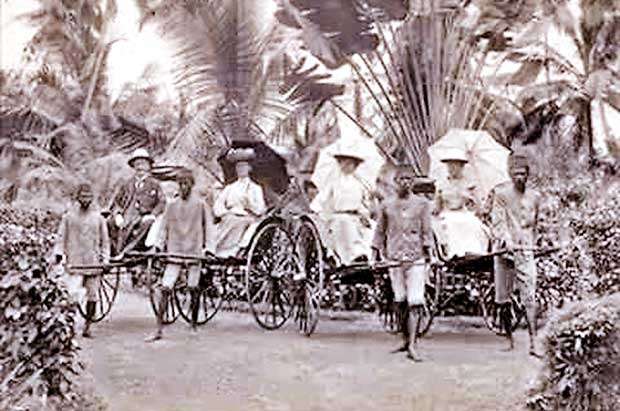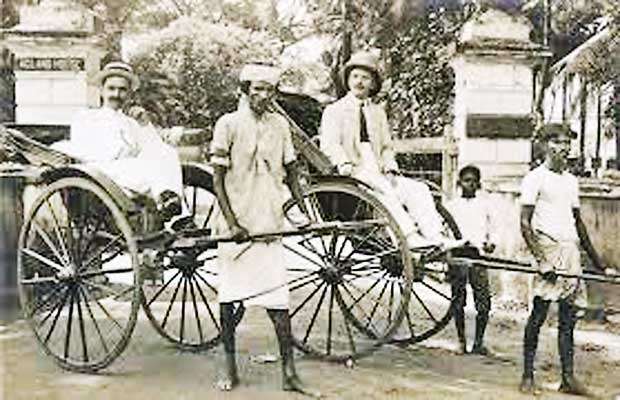Reply To:
Name - Reply Comment
Last Updated : 2024-04-26 05:10:00

 The formation of elites in colonial societies has been the subject of fierce debate. Probably the main reason for that has been the debate over the definition of elite: Who is elite and who is not? In the Sri Lankan context, we can try addressing this issue by tracing the political shifts and the changing layers of elitism that made up, and later unmade, the campaigns for labour rights, suffrage, and independence.
The formation of elites in colonial societies has been the subject of fierce debate. Probably the main reason for that has been the debate over the definition of elite: Who is elite and who is not? In the Sri Lankan context, we can try addressing this issue by tracing the political shifts and the changing layers of elitism that made up, and later unmade, the campaigns for labour rights, suffrage, and independence.
The emergence of a new elite in the latter half of the 19th century in Sri Lanka has been compared by certain sociologists and historians to the Tory-Whig power contests in Britain. The Tory-Whig contests, however, ended in 1832 with the enactment of the Reform Act, which gave political power to the middle class. The middle class here, by contrast, had to clamour for representation even as their economic power remained at odds with their political weakness long after the Whigs had won. One reason adduced for this incongruity between the elite’s economic power and political weakness is the fact that there was disagreement between the Colonial Office and colonial authorities; The former accommodated calls for legislative reforms, while the latter, whose anti-democratic views were far behind the liberalism espoused by Parliamentarians back home, were opposed to the mildest reforms.
In this scheme of things, the colonial authorities, all the way to Caldecott, favoured the section of the elite (old or new) that fell in line with their ultra-conservatism. The absence of a nationalist bourgeoisie in Ceylon was inevitable in a context where the commercial interests of the bourgeoisie and the colonial authorities didn’t clash with each other.
The absence of a nationalist bourgeoisie in Ceylon was inevitable in a context where the commercial interests of the bourgeoisie and the colonial authorities didn’t clash with each other
The more politically conscious section of this new bourgeoisie was frustrated by their lack of economic advancement owing to the lack of credit facilities (Which remained the monopoly of the British), but as has been pointed out, they ended up channelling their discontent through chauvinism, as was the case during the riots of 1915.
They were mesmerised by the Sinhala Buddhist consciousness that grew in the latter half of the 19th century and they soon became the benefactors of the revivalist program that Anagarika Dharmapala and the Theosophists inaugurated.
While the nascent bourgeoisie referred to above had been aspiring entrepreneurs before the Colebrooke-Cameron Reforms, it was through those reforms that they were able to harness their entrepreneurial spirit and realise their class interests.
The shift in the 1830s and 1840s, as K. M. de Silva pointed out, was from an authoritarian system of governance that gave arbitrary powers to the Governor to a laissez-faire structure that, while not conducive to nationalists, reformists, and radicals, enabled deeply felt social changes at least throughout the urban centres.
These reformist undercurrents, of course, were tinged with evangelical zeal, and they reflected the shift from Orientalism to Utilitarianism in India.
The ease with which colonial authorities facilitated this shift here can be explained by the simple fact that unlike in India, the evangelist in Ceylon did not have a pagan culture to combat: there were no thuggies, sati poojas, or meriah sacrifices.
The caste system, of course, was the only real remnant of a pagan culture we had, but even that was less insidious than in India; in any case the British did not do away with it, substituting for it a “colonial caste system” that, for a long time, favoured the Govigama elite and later, after the appointment as Mudliyars of Gregory de Zoysa in 1845 and of Jeronis de Soysa in 1853, made room for a Salagama and Karava elite.
The Governor opposed the Commission Reform proposals, not merely because they sought to reduce his powers in favour of an Executive Council but also because, in his view, the people of the country “could nor ought to have under existing circumstances any greater share in the Government than they have at present.”
This reflected, and in a way predicted, the tussle that was to continue between the Colonial Office and the colonial authorities. But for the time being, Governor Barnes was overruled.
With the implementation of the Commission proposals, Ceylon was on its way to becoming an underdeveloped, semi-feudal plantation economy, which as S. B. D. de Silva pointed out was “Another backward sector with no impulse to grow” to which European civilisation had been inserted with a “skipping of all intermediate stages.”
Any discussion of the economy and the underdevelopment it facilitated must hence start off with the nature of elite formation here, in terms of three related phenomena: education, “bourgeoisification”, and religious revival. And in that order.
The three most frequently associated traits of the Ceylonese elite, as inferred from a despatch by Henry McCallum in 1910, was that it was Anglicised, Western-educated, and alienated from the people.
K. M. de Silva makes a convincing case against this stereotype by arguing that, for instance, the elite were responsive to the value systems of the people and that English education, which in plantation economies was essential in distinguishing those who had made it from those who had not, was not a prime determining factor. But of course, that was not always the reality. The old elite maintained what was at one level a semi-feudal relationship with the inhabitants of the villages; accounts have been told of, for instance, Solomon Dias Bandaranaike whipping villagers who did not bow down before him if he happened to pass their way. Even after the abolition of rajakariya the old elite – the Bandaranaike-Obeyesekere clique – used their coercive powers to dragoon illegal and unpaid labour from villagers.
It was for this reason that the British compared this elite to Zamindars, and why they were preferred to the new rich who, while certainly not reformist (They rationalised their demands in terms of the loyalty to the British Crown those demands would obtain from the locals) were for suffrage, no matter how restrictive it was (less than one per cent of the population), and limited constitutional reforms.
But culturally and socially, it cannot be said that the elite, particularly the old elite, were responsive to the traditional values of their own people. Although not all of the new elite converted to Christianity, the more powerful among them did, especially the family of Jeronis Pieris, which converted not only from Buddhism to Catholicism but later from Catholicism to Anglicanism.

What differentiated them from the new elite was the fact that they were not entrepreneurs in the strict sense of that term. Nevertheless, the land bequeathed to them by the British as gifts for their loyalty was transformed into estates for coffee, tea, coconut, graphite, and plumbago.
Their bourgeoisification and their choice of clothes, furniture, and architecture thus predated the lavish lifestyles indulged by the nouveau riche; they wore a “unique combination of Western and Eastern dress”, while their residences exhibited “European taste engrafted on Sinhalese customs.”
As for English education, consider that even as secular an institution as the Colombo Academy (Royal College) had as its principals Joseph Marsh and Barcroft Boake, the latter of whom, in a pamphlet in 1854, denounced the links between the State and the “Idolatrous system of religion” in the country, and the former of whom, as its first principal, founded it as a private school (then called the Hill Street Academy) one year before it was turned into a public school, to teach English to children of elite Burgher families.
Boake furthermore was considered an ideal tutor by those who wanted their children to obtain a proper education: Jeronis Pieris reportedly told Charles de Soysa once that he was the “best Tutor you could find in the Island.”
The rush for English and Western education, in this sense, was certainly a key determining factor in the formation of the (new and old) elite, contrary to de Silva’s contention. There was “insatiable anxiety” to be Westernised and Anglicised and here modernisation was erroneously equated with Westernisation, although the more enlightened sections of the bourgeoisie looked to British rationalism and liberalism for the modernising influences that were lacking among the local elite.
De Silva’s contention about education not being a determining factor, moreover, can be countered by his own thesis that in the Anglicised lifestyle “English education was a fundamental characteristic.” The inference is obvious: how could it be fundamental if it were not a key factor? Ergo, if the elite continued to project a fanciful lifestyle that was distinguished by their efforts at becoming “more English than the English”, how were they not cut off from, and unresponsive to, the local milieu?
The semi-feudal relationship between the old elite and the villager may have been evidence for the responsiveness of the former to the latter; beyond this, there was no link. The new elite, on the other hand, came from more humble beginnings, but they were as incapable of forming an alliance with locals against British rule; the closest they came to here was the religious revival of the 19th century, though even that did not become the nationalist-revivalist programme it was envisioned as.

Add comment
Comments will be edited (grammar, spelling and slang) and authorized at the discretion of Daily Mirror online. The website also has the right not to publish selected comments.
Reply To:
Name - Reply Comment
US authorities are currently reviewing the manifest of every cargo aboard MV
On March 26, a couple arriving from Thailand was arrested with 88 live animal
According to villagers from Naula-Moragolla out of 105 families 80 can afford
Is the situation in Sri Lanka so grim that locals harbour hope that they coul